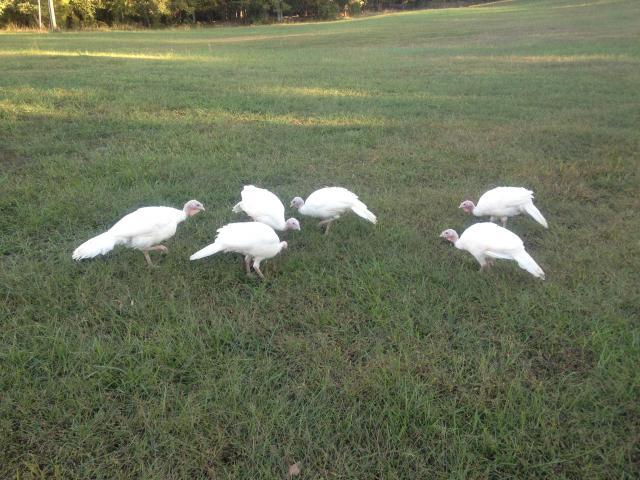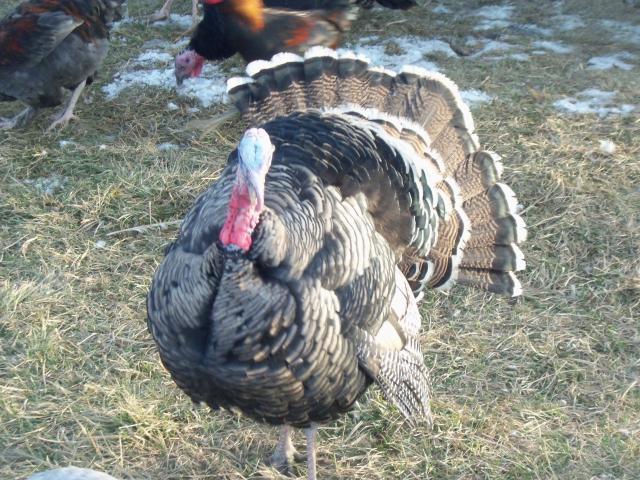I guess I should throw in here that I picked up a tom and hen Beltsville at Crossroads to go with the single hen I have from my doomed hatch this spring. If I can get them through the winter, that trio should give me a nice start next spring.
Navigation
Install the app
How to install the app on iOS
Follow along with the video below to see how to install our site as a web app on your home screen.
Note: This feature may not be available in some browsers.
More options
You are using an out of date browser. It may not display this or other websites correctly.
You should upgrade or use an alternative browser.
You should upgrade or use an alternative browser.
Heritage & Exhibition Turkey Thread
- Thread starter HallFamilyFarm
- Start date
- Thread starter
- #102
Quote:
Not that it should go on this thread, but Jen was also seen leaving Crossroads with some Heritage Cotton Patch Geese!
Good to see more Turkeys in Southeast Arkansas. Should add a little bit more competition in the area shows.
Not that it should go on this thread, but Jen was also seen leaving Crossroads with some Heritage Cotton Patch Geese!
Good to see more Turkeys in Southeast Arkansas. Should add a little bit more competition in the area shows.
I have a question. I know I have like 5 tom turkeys out of 8 turkeys in my pen. We are keeping the one that i believe is a Bourbon Red. I have 3 of them that I am not sure of, well 1 I know for sure is a hen but the other 2 I don't know. I have pictures of them if any one can tell me if they are hens for sure of not.
http://www.facebook.com/photo.php?f...1573879846619.62888.1824261821&type=3&theater
http://www.facebook.com/photo.php?f...1573879846619.62888.1824261821&type=3&theater
http://www.facebook.com/photo.php?f...1573879846619.62888.1824261821&type=3&theater
This bottom picture has two of my toms in it but the brown one is the one we are keeping and hoping that him and what hens I have may be able to breed and we can have babies.
http://www.facebook.com/photo.php?f...1573879846619.62888.1824261821&type=3&theater
http://www.facebook.com/photo.php?f...1573879846619.62888.1824261821&type=3&theater
http://www.facebook.com/photo.php?f...1573879846619.62888.1824261821&type=3&theater
This bottom picture has two of my toms in it but the brown one is the one we are keeping and hoping that him and what hens I have may be able to breed and we can have babies.
Quote:
Not that it should go on this thread, but Jen was also seen leaving Crossroads with some Heritage Cotton Patch Geese!
Good to see more Turkeys in Southeast Arkansas. Should add a little bit more competition in the area shows.
I am going nuts looking for CP Geese out here in the west.

Going to contact Mr Walker again.
Not that it should go on this thread, but Jen was also seen leaving Crossroads with some Heritage Cotton Patch Geese!
Good to see more Turkeys in Southeast Arkansas. Should add a little bit more competition in the area shows.
I am going nuts looking for CP Geese out here in the west.

Going to contact Mr Walker again.
You wanted pictures, and here they are....
MW's



MW's



- Thread starter
- #106

Question.... Are MW's considered a "Heritage" turkey? I know the history, and it doesn't go back very far. Second Question.....If one wanted to show MW's, what should one do?
- Thread starter
- #108
The American Poultry Association currently recognizes the following varieties of Turkeys:
Black
Bourbon Red
Slate
Narragansett
White Holland
Bronze
Beltsville White
Royal Palm
Other varieties may be shown in exhibition, but can only win AOV: "All Other Variety" if a quality standard recognized variety is present.
As for the Midget Whites, they are not a recognized variety in the Standard of Perfection. However, they were developed prior to the mid 1960's. Thus debatable if a Heritage breed or not. The ALBC lists them as Critical. You are still welcome to exhibit them. Any turkey is better than no turkey!
Black
Bourbon Red
Slate
Narragansett
White Holland
Bronze
Beltsville White
Royal Palm
Other varieties may be shown in exhibition, but can only win AOV: "All Other Variety" if a quality standard recognized variety is present.
As for the Midget Whites, they are not a recognized variety in the Standard of Perfection. However, they were developed prior to the mid 1960's. Thus debatable if a Heritage breed or not. The ALBC lists them as Critical. You are still welcome to exhibit them. Any turkey is better than no turkey!
http://www.albc-usa.org/cpl/midgetwhite.html
Midget White Turkey
The Midget White turkey was created in the early 1960s by Dr. J. Robert Smyth at the University of Massachusetts. It was developed to meet an anticipated demand for a small version of the broad breasted turkey. Since this market did not develop as predicted, the Midget White never become widely popular.
Soon after the development of the Midget White, the University of Massachusetts had to reduce its poultry holdings. The Midget White turkeys were dispersed. Dr. Bernie Wentworth, a former graduate student of Dr. Smyths, never forgot these turkeys. Much to his surprise, Dr. Wentworth, who had taken a position on the faculty of the University of Wisconsin, found some of these turkeys, with University of Massachusetts wing bands in the flock of a backyard fancier. These birds were added to the University of Wisconsins poultry program, which continued to refine and then fix the standard for the Midget White variety we know today. Dr. Wentworth is largely credited in preventing the breeds extinction. As Dr. Wentworth prepared to retire in the late 1990s, the university decided to disperse the flock. Some were passed to poultry hobbyists, but the majority of the flock was sent to the USDA poultry facility in Beltsville, Maryland. The Beltsville flock was dispersed in April of 2005 and the remaining birds were distributed to poultry enthusiasts located in the eastern US. The survival of this breed now lies completely in the hands of private individuals. It is important to note that the Midget White turkey does not have any genetic relationship to the Beltsville White and that the two breeds are distinct and should be managed separately.
The Midget White, with its broad breast, has the appearance of a miniature of the commercial Broad Breasted White turkey. This quality provides the variety with good meat production and makes the Midget White a fine table fowl. The variety was developed from a cross of a commercial Broad Breasted White turkey and an exhibition Royal Palm. Midget White toms average 13 lbs., hens average 8 lbs. In Wisconsin, the birds were selected for higher egg production, fertility, and hatchability. The hens laid an average of 60-80 large eggs per year, weighing only three to five grams less than those of the broad breasted white turkey. Hatchability was 75-80%.
When breeding Midget White turkeys, care should be taken in the selection of breeding stock to retain the small size of the breed. Once the young turkeys are well feathered they have the ability to fly, so care must be taken to prevent escape. Adult Midget Whites are less likely to take flight as they get heavier. These diminutive turkeys are unusually friendly and will approach people and pets without much concern.
Status: Critical
Midget White Turkey
The Midget White turkey was created in the early 1960s by Dr. J. Robert Smyth at the University of Massachusetts. It was developed to meet an anticipated demand for a small version of the broad breasted turkey. Since this market did not develop as predicted, the Midget White never become widely popular.
Soon after the development of the Midget White, the University of Massachusetts had to reduce its poultry holdings. The Midget White turkeys were dispersed. Dr. Bernie Wentworth, a former graduate student of Dr. Smyths, never forgot these turkeys. Much to his surprise, Dr. Wentworth, who had taken a position on the faculty of the University of Wisconsin, found some of these turkeys, with University of Massachusetts wing bands in the flock of a backyard fancier. These birds were added to the University of Wisconsins poultry program, which continued to refine and then fix the standard for the Midget White variety we know today. Dr. Wentworth is largely credited in preventing the breeds extinction. As Dr. Wentworth prepared to retire in the late 1990s, the university decided to disperse the flock. Some were passed to poultry hobbyists, but the majority of the flock was sent to the USDA poultry facility in Beltsville, Maryland. The Beltsville flock was dispersed in April of 2005 and the remaining birds were distributed to poultry enthusiasts located in the eastern US. The survival of this breed now lies completely in the hands of private individuals. It is important to note that the Midget White turkey does not have any genetic relationship to the Beltsville White and that the two breeds are distinct and should be managed separately.
The Midget White, with its broad breast, has the appearance of a miniature of the commercial Broad Breasted White turkey. This quality provides the variety with good meat production and makes the Midget White a fine table fowl. The variety was developed from a cross of a commercial Broad Breasted White turkey and an exhibition Royal Palm. Midget White toms average 13 lbs., hens average 8 lbs. In Wisconsin, the birds were selected for higher egg production, fertility, and hatchability. The hens laid an average of 60-80 large eggs per year, weighing only three to five grams less than those of the broad breasted white turkey. Hatchability was 75-80%.
When breeding Midget White turkeys, care should be taken in the selection of breeding stock to retain the small size of the breed. Once the young turkeys are well feathered they have the ability to fly, so care must be taken to prevent escape. Adult Midget Whites are less likely to take flight as they get heavier. These diminutive turkeys are unusually friendly and will approach people and pets without much concern.
Status: Critical
thebirdguy
Songster
My Narrangansett tom put on a little show tonight and I snapped a quick picture to share... He's almost 6 months old


- Thread starter
- #110
Quote:










New posts New threads Active threads
-
Latest posts
-
-
-
Shadrach's Ex Battery and Rescued chickens thread.
- Latest: kattabelly
-
-
-
-
Latest threads
-
My hen has trouble breathing, like bubbles in throat and crop?
- Started by Moondoll
- Replies: 0
-
-
-
-
-
-
Threads with more replies in the last 15 days
-
Heater or heat panel -10
- Started by IowaCHKN
- Replies: 162
-
Introducing TUDYBOOK - The Tudy Coloring Book Generator
- Started by Nifty-Chicken
- Replies: 57
-
-
Question of the Day - Sunday, December 21st, 2025
- Started by casportpony
- Replies: 44
-
-
×


